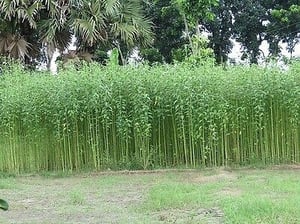
Continuing our blog series 'Sustainable Materials', this week's article considers Jute. A versatile, organic material often used in the creation of promotional items like shopper bags, cosmetic pouches and GWP packaging.
jute
Jute is a vegetable fibre, mostly grown in tropical countries like India and Bangladesh. Its production is easy, and the fibre is sturdy & biodegradable, making it perfect for a variety of products ranging from rugs, shopping bags & curtains to flour sacks and sacks to carry grains like wheat and rice. It is often used to make outdoor cushions, laundry baskets, and aprons because of its sturdiness. As a material it is considered the second most versatile fabric after cotton, and the second most common fibre grown and used across the world.
Where does Jute come from?

Most jute comes from the bark of the white Jute plant (Corchorus capsularis). It's harvested once a year, after a growing season of around four months. Jute has a golden hue, so is sometimes called Golden Fibre. It is light and has a flexibility & bounce unlike other fibres.
It grows best in tropical zones with mid-to-high humidity, in places such as India and Bangladesh, Nepal and Myanmar. Almost 90% of the world's jute comes from Bangladesh. Jute farmers rotate their crops, to help keep the soils healthy and vibrant, so each crop of jute remains strong and full of life. t thrives on rain, and with enough water, there's little need for fertiliser to help it along. Nor does it need pesticides.
How is Jute rope made?
Jute fibres range in length from one to four metres. The stems are cut, then bundled together in packs, before being soaked in water for periods of time to separate and loosen the fibres. This is called biological retting. Once this is done, the outer non-fibrous matter is scraped off, and then the softened fibres can be pulled straight out from inside the jute stem. It's a time consuming process but it does not include any chemicals.
This retting process can also be done chemically to strip the fibres from the stem, but it's much more expensive, therefore the majority of producers find it's just as easy to employ the natural method using water. These fibres are then processed into threads, which are then woven together to make jute threads (and from this into fabric), or jute rope.
What can Jute be used for?
 Jute fabric is super versatile and strong. The most common application is as sackcloth, but jute can be used for many purposes. It can be made into textiles including:
Jute fabric is super versatile and strong. The most common application is as sackcloth, but jute can be used for many purposes. It can be made into textiles including:
- Yarn
- Twine
- Sacking
- Hessian
- Carpet backing cloth
Which in turn can be used to make:
- Curtains
- Chair coverings
- Carpets
- Area rugs
- Indoor rugs
Is Jute considered sustainable?
Jute has an overall positive impact on the environment. In fact, it is one of the few natural fibres that actually provides environmental benefits instead of being detrimental. But the major positive characteristic of jute is, that it uses way less water to produce, and the production of jute is much more eco-friendly than any other fabric.
End of Life - Jute fibre is 100% biodegradable and recyclable, and does not create toxic gas when burned. This means jute products such as rugs, mats, bags and carry bags, can go straight back into the compost when they're too old to be of use anymore. All disposal methods for jute, including burning, produce a negligible environmental impact. While synthetic fibres release toxic chemicals into the air when incinerated or remain in the environment for centuries when they are discarded in landfills, jute and other natural fibres rapidly reabsorb into surrounding ecosystems, whether they are disposed of properly or not.
Symbiotic crops - Both rice and jute are generally grown in the same areas, since these crops require similar growing environments. While rice depletes the soil in which it is grown, jute production actually returns nutrients to the soil and helps retain soil moisture. Therefore, rice and jute are symbiotic crops, and growing these two agricultural products together diminishes the environmental impact of rice cultivation.
As with all types of fibre crop cultivation, however, there is both a right and a wrong way to cultivate jute. If jute is not grown sustainably by following basic practices like crop rotation, this crop could hurt the surrounding soil. While jute production generally does not necessitate the use of chemical fertilizers and pesticides, if cultivators of this crop use these toxic chemicals in their production processes, jute’s environmental impact can rapidly become negative.
Supporting Local Communities -

The one significant way in which jute production could be harmful is in its effects on local economies. Most jute producers in Bangladesh and other areas are independent; they are locally-owned, and the majority of their products are sold into the surrounding region instead of being exported overseas.
Jute production facilities that are owned by major corporate conglomerates, however, may absorb value from local jute-producing communities without giving back.
This lack of economic stimulus dis-empowers jute producers from pursuing proper environmental stewardship, and exploitative cultivation policies may also encourage unsustainable or environmentally-unfriendly production processes. Therefore, it’s best to purchase jute fabric produced by independent companies that follow strict organic environmental stewardship protocols.
Organic Credentials - Since jute is a plant-based fibre, it is eligible for organic certification from governmental organic certification agencies such as the U.S. Department of Agriculture and the European Union’s organic certification agency. Since most jute is grown outside of the United States or EU, however, these certifications aren’t highly relevant. On the other hand, the Global Organic Textile Standard (GOTS) provides organic certification for textile fibres produced all around the world. All jute fibres are eligible for GOTS certification as long as they meet certain stringent criteria.
Are you looking for innovative, sustainable marketing services support? Contact us to discover how ASL can help your marketing campaigns become more environmentally sustainable and socially responsible.

Discover more about our ONE WORLD initiative







